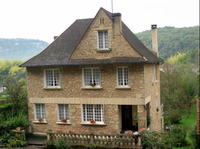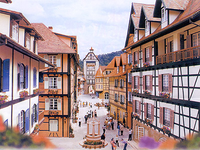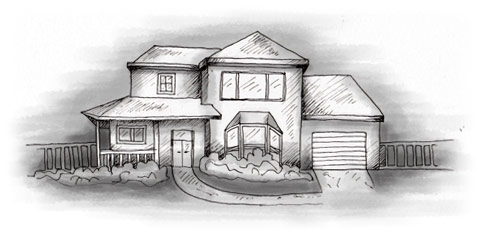French homes are built to high structural standards and, whether you buy a new or an old home, it will usually be extremely sturdy. Older homes often have thick walls and contain numerous rooms. Most have a wealth of interesting period features, including vast fireplaces, wooden staircases, attics, cellars (caves), and a profusion of alcoves and annexes. Many houses have a basement (sous-sol or cave), used as a garage and cellar. In most old houses, open fireplaces remain a principal feature even when central heating is installed. In warmer regions floors are often tiled and walls are painted rather than papered, while elsewhere floors are carpeted or bare wood, and walls are more likely to be papered. When wallpaper is used, it’s often garish and may cover everything, including walls, doors and ceilings! Properties throughout France tend to be built in a distinct local (often unique) style using local materials. There are stringent regulations in most areas concerning the style and design of new homes and the restoration of old buildings.

In older rural properties, the kitchen (cuisine) is the most important room in the house. It’s usually huge with a large wood-burning stove for cooking, hot water and heating, a huge solid wood dining table and possibly a bread oven. French country kitchens are worlds apart from modern fitted kitchens and are devoid of shiny formica and plastic laminates. They’re often comparatively stark, with stone or tiled floors and a predominance of wood, tiles and marble. Kitchens in older apartments in Paris and other cities may be very basic, although modern fitted kitchens (with dishwashers, cookers and refrigerators) are usually found in new properties, and ‘American kitchens’ (i.e. open plan kitchens separated from the living or dining room by a bar or counter) are increasingly common. New homes usually also contain many ‘luxury’ features, e.g. deluxe bathroom suites, fitted cupboards, smoke and security alarms, and coordinated interior colour schemes. New homes are usually sold décorée, which means not only that they’re decorated but also that they have a fitted kitchen.
Refrigerators (frigidaire or frigo) and cookers (cuisinière) are generally quite small. Cookers in rural homes are usually run on bottled gas or a combination of bottled gas and electricity. Many homes have a gas water heater (chaudière) that heats the water for the bathroom and kitchen. Most houses don’t have a separate utility room and the washing machine and drier are kept in the kitchen. A separate toilet (toilette or WC/water) is popular, and the bathroom (salle de bains) often has a toilet, a bidet, a bath (baignoire) and/or a shower (douche). Baths are more common than showers in older homes, although showers are found in most modern homes. Note that many old, unmodernised homes don’t have a bath, shower room or an inside toilet.
Shutters
Many rural properties have shutters (volets), both for security and as a means of insulation. External shutters are often supplemented by internal shutters that are fixed directly to the window frames. In France, windows open inwards rather than outwards, as in most other countries. In the south and south-west, many rural homes have outdoor swimming pools, and homes throughout France have a paved patio or terrace, which is often covered. Old farmhouses invariably have a number of outbuildings such as barns, which can usually be converted into additional accommodation.
A huge variety of new properties is available in France, including city apartments and individually-designed, detached houses. Many new properties are part of purpose-built developments. Note, however, that many of these developments are planned as holiday homes and they may not be attractive as permanent homes (they’re also generally expensive). If you’re buying an apartment or house that’s part of a development, check whether your neighbours will be mainly French or other foreigners. Some people don’t wish to live in a commune of their fellow countrymen and this will also deter French buyers if you want to sell. Prices of new properties vary considerably according to their location and quality.
French Architecture

France’s bold and innovative architecture, as portrayed in its many striking public buildings, doesn’t often extend to private dwellings, many of which seem to have been designed by the same architect. However, although new properties are often lacking in character, they’re usually spacious and well endowed with modern conveniences and services, which certainly cannot be taken for granted in older rural properties. Standard fixtures and fittings in modern houses are more comprehensive and of better quality than those found in old houses. The French generally prefer modern homes to older houses with ‘charm and character’ (which to the locals mean ‘expensive to maintain and in danger of falling down’!), although new homes often have pseudo period features such as beams and open fireplaces in new homes. Central heating, double glazing and good insulation are common in new houses, particularly in northern France, where they’re essential. Central heating may be electric, gas or oil-fired. However, on the Côte d’Azur, where winter temperatures are higher, expensive insulation and heating may be considered unnecessary (don’t you believe it!). Air-conditioning is rare, even in the south of France.
Note that most French families live in apartments or detached homes, and semi-detached and terraced properties are relatively rare. Some 45 per cent of the population lives in apartments (although less than 10 per cent in tower blocks), which are more common in France than in most other European countries. In cities and suburbs, most people have little choice, as houses are in short supply and prohibitively expensive. In the major cities there are many bourgeois apartments, built in the 19th or early 20th century, with large rooms, high ceilings and huge windows. Unless modernised, they have old fashioned bathrooms and kitchens and are expensive to decorate, furnish and maintain. Many apartments don’t have their own source of hot water and heating, which is shared with other apartments in the same building.
For details of typical homes in the most popular regions of France, refer to The Best Places to Buy a Home in France. For information about buying a plot and having a house built to your own specification.
This article is an extract from Buying a home in France. Click here to get a copy now.

